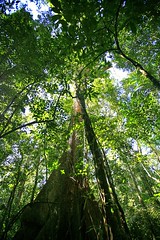The South American rain forest of the Amazon basin is the largest in the world, covering about 8,235,430 km2 with dense tropical forest. For centuries, this has protected the area and the animals residing in it.
Not all of the big plant and animal that live in the Amazon Basin are known because of its huge unexplored areas. No one knows how many species of fish there are in the river.
Wet tropical forests are the most species-rich biome, and tropical forests in the Americas are consistently more species rich than the wet forests in Africa and Asia.[16]
As the largest tract of tropical rainforest in the Americas, the Amazonian rainforests have unparalleled biodiversity. One in ten known species in the world live in the Amazon Rainforest.[17] This constitutes the largest collection of living plants and animal species in the world.
The region is home to about 2.5 million insect species,[18] tens of thousands of plants, and some 2,000 birds and mammals. To date, at least 40,000 plant species, 3,000 fish, 1,294 birds, 427 mammals, 428 amphibians, and 378 reptiles have been scientifically classified in the region.[19]
One in five of all the birds in the world live in the rainforests of the Amazon. Scientists have described between 96,660 and 128,843 invertebrate species in Brazil alone.[20]
The diversity of plant species is the highest on Earth with some experts estimating that one square kilometer may contain over 75,000 types of trees and 150,000 species of higher plants.
In many regions, the forest has been cleared for soy bean plantations and ranching (the most extensive non-forest use of the land) and some of the inhabitants harvest wild rubber latex and Brazil nuts. This is a form of extractive farms, where the trees are not cut down, and thus this is a relatively sustainable human impact.
skip to main |
skip to sidebar
For students and parents who love education and exploration of the social sciences . . .
Search This Blog
Followers
Blog Archive
-
▼
2009
(379)
-
▼
November
(30)
- TE Lawrence: a study of the meeting between Europe...
- Enriched geography requirements: one book per seme...
- European connections to the Caribbean
- Magnet 2013 Crepe Myrtle Planting successful: 30 t...
- Jamaicans created rock steady and ska as well as r...
- Rastafarians: a recent religious group born in Jam...
- Jamaican singer-songwriter Bob Marley, 1945 - 1981
- Roda de Capoeira: an Afro-Brazilian dance/sport th...
- Tues: bring shovels; Thurs: crepe myrtle planting day
- Wed, Nov 18: Caribbean map & open notes quiz
- One of Brazil's many rock bands, Sepultura has sol...
- US has held an embargo against Cuba for 47 years -...
- Map quiz: sketch and identify continents, nations ...
- Once Upon A Mattress: a comedy from Magnet Drama a...
- Comparing Caribbean Islands to archipelagos on oth...
- St. Croix, the US Virgin Islands
- San Juan, capital of the Commonwealth of Puerto Rico
- American mogul Bill Gates, "world's wealthiest man...
- Prince Henry the Navigator, a Bill Gates of the 14...
- Yerba mate: the ritual drink of Argentina and much...
- Homework in Geography / Trudeau: Read web site not...
- Trinidad: Caribbean island with the largest of all...
- 600 miles into the Pacific lies the Ecuadorian arc...
- Plan to eat well at the Homecoming picnic on Friday
- Valuable but endangered: the Amazon basin
- Environmentally-focused California clothing compan...
- Social Studies Fair Project guidelines reminder
- At the southernmost tip of the Western continents:...
- Mapa antiguo de América del Sur, me hearties!
- Rio de Janeiro, Sao Paulo and Brazil: this week's ...
-
▼
November
(30)

